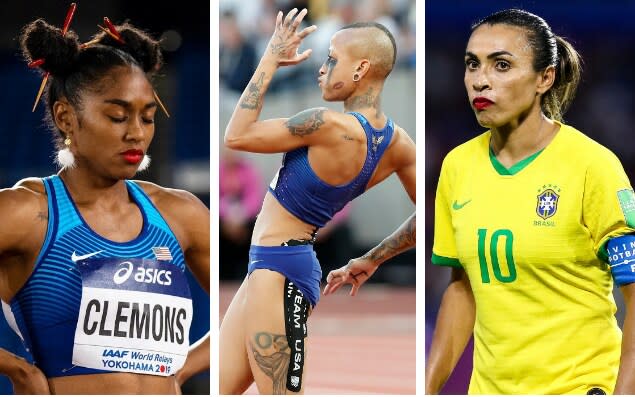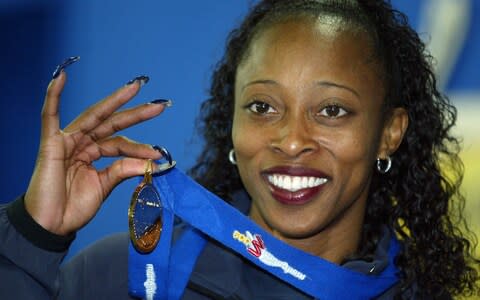Athletes are able to show the world who they are with appearance, and the results can be empowering


One of the many things I love about track and field is its powerful history of self-expression, through the aesthetic. In our sport, athletes have long played with their appearance, be that the one-legged leotards of the 1980s, Gail Devers and her nails in the Nineties, Cathy Freeman’s iconic speed suit of Sydney 2000 or the hair and make-up styles that we have seen of late, whether that has been in national colours, or cute little flags painted on athlete’s faces.
The high jumper Inika McPherson – who, despite being only 5ft 4in, was the highest-placed United States finisher at the London 2017 World Championships – made a huge impression with her Batman- style make-up.
And the hurdlers, particularly the Americans, are always doing something innovative. At last year’s World Relays in Tokyo, Christina Clemons was inspired by Japanese culture, putting chopsticks in her hair; while 400 metres hurdler Shamier Little is known for competing with a bow in her hair – an accessory that has become an intrinsic part of her race-day identity, as she writes on her Instagram page, #FearTheBow.
Self-expression is at the core of track and field. And I am talking wider than just aesthetics of course. We are always chasing personal bests, using our bodies each with their own unique movement patterns, to try to be the best in the world at a chosen discipline. When it is “go time” or a championship environment, performances are the product of years of hard work and discipline. It is the moment when the world gets to see who the athletes really are through displays of determination, passion and emotion.
Everyone is different, and obviously there should be no scripted way for athletes to present themselves, but many choose to personalise their image. I believe that whenever you step on to a track to compete, it is a performance, in its widest sense, and I find that idea really empowering.

Whenever I pull on my spikes at a major championships I am bringing my best, most confident and fastest self into the arena. And at that moment that includes expressing myself aesthetically. Self-expression for me right now reflects my mood. I am still young, I am still growing into myself, and I like to have fun with it. Every year it is different – last year was eye shadow. My coach John Blackie still jokes about it. The year before it was scrunchies, and who knows what it will be this season!
While there was a fair bit of coverage about the eye shadow I wore in Doha, outside of Qatar no one seemed to notice the pearls! I like to politely nod to the culture of whichever country I am competing in, and so I did a bit of research. I had been to Qatar before for the Diamond League and noticed fishing boats everywhere. I found out about the history of pearling there – it was Qatar’s primary industry before oil was discovered in the 1940s. My coach told me about the Pearl Carpet of Baroda – a rug in Qatar’s national museum, embellished with pearls, diamonds, rubies and emeralds. And so I wore a hairband of pearls in homage to Qatari culture.
Had a media session before training today. Usually I’d take some of my make-up off before I got into track to tone it down a little, but @dinaashersmith made history last week in pink glittery eyeshadow, so it stays ��
— Elinor Barker (@elinorbarker) October 7, 2019
Sometimes the way people dress or present themselves can have a deeper, more personal meaning. It gives them the confidence and spirit they need to compete well. Shannon Rowbury wore bright pink lipstick while racing in 2015.
Her reason for wearing it, in memory of her grandmother, was so poignant. She told the press: “She was like a second mom to me and I loved her very dearly. She would always wear hot pink lipstick.” And she went on to give a powerful insight into her mindset that day: “Races are pretty special occasions – I only race maybe 20 times a year. When you decide to put a hot pink lipstick on, you better bring your A game.”

Track is not unique in this regard, of course, football’s most iconic female player, Marta, wore deep red lipstick in her final match of the World Cup last year. “The colour is of blood,” she said afterwards, “because we had to leave blood on the pitch.”
Speaking directly into the camera, she made an impassioned speech to future generations to take up the mantle of the women’s game. “It’s wanting more,” she said in Portuguese. “It’s training more. It’s taking care of yourself more. It’s being ready to play 90 plus 30 minutes. This is what I ask of the girls. There’s not going to be a Formiga forever. There’s not going to be a Marta forever. There’s not going to be a Cristiane. The women’s game depends on you to survive.”

This legacy of expression manifests itself in wider culture too – Beyonce dressing as a sprinter for Hallowe’en, or Virgil Abloh’s Paris Fashion Week show for Off White, one of the biggest sport streetwear brands right now. To see our sport affecting mainstream culture makes me proud, and I sincerely hope that athletes, both men and women, continue to have the confidence to express themselves in whichever way they see fit.
Self-expression enhances our sport, and I for one am glad it is here to stay.

